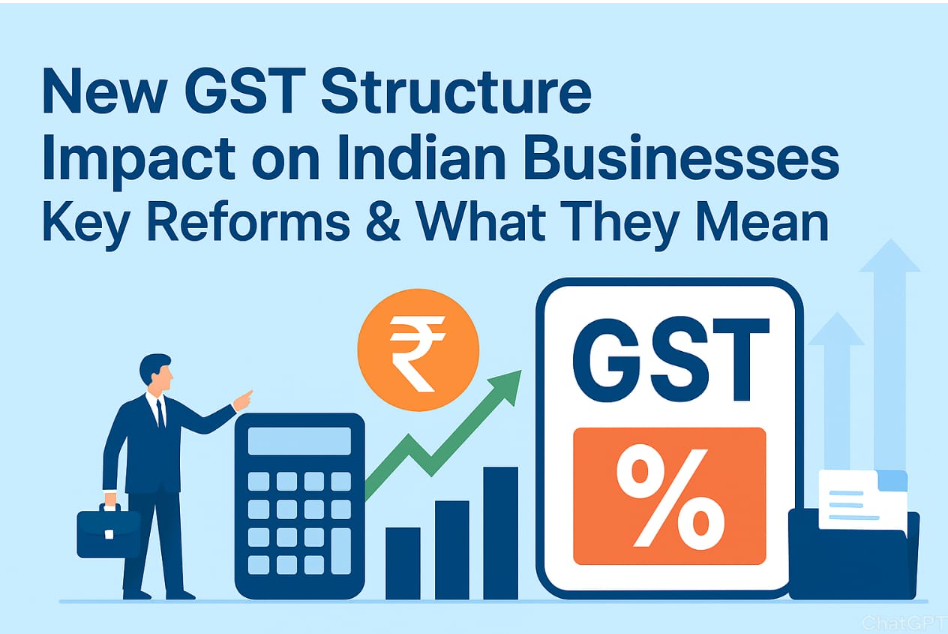
New GST Structure Impact on Indian Businesses
India's Goods and Services Tax has reshaped the economy since its start in 2017. Now, with fresh changes, it pulls in over 7 trillion rupees each year, fueling growth across sectors. These updates hit businesses hard, from small shops to big factories, by tweaking rates and rules.
GST began as a single tax to replace old state levies. Over time, councils met to fix issues like high rates on basics. In 2024, they cut slabs and eased filings, aiming to help trade flow better. This new setup changes how you handle taxes, cut costs, and grow your firm. It boosts some areas while adding hurdles in others, so Indian businesses must adapt fast to stay ahead.
Overview of the New GST Structure
The latest GST tweaks focus on fewer rates and easier steps. This helps cut confusion for daily operations. Businesses now face a clearer path to follow rules without constant worry. Click here
Beyond sectoral changes, the reforms also target logistics, packaging, transport, and infrastructure. For example
- GST on commercial goods vehicles and their insurance reduced.
- Packaging materials brought under 5% GST to ease costs.
The goal is to rationalize rates, reduce cascading costs, and make everyday goods & services more affordable — especially for youth and lower / middle income groups.
Impact on Indian Businesses: Opportunities & Challenges
Opportunities & Benefits
1.Cost Reduction in Key Sectors
Businesses in textiles, leather, handicrafts, food processing, and packaging will see direct savings in input costs. Lower GST on raw materials and intermediates means improved margins
2.Boost to Exports & MSMEs
With lower GST rates on export-oriented sectors, Indian goods become more price-competitive internationally. MSMEs can benefit more due to lower tax burden.
3.Consumer Demand Surge
Lower taxes on essentials, mobility, healthcare, and fitness may lead to increased consumer spending. That can open markets for small and medium businesses.
4.Simplified Life for Businesses
Rationalized slabs reduce complexity. Fewer anomalies and more uniform rates make compliance easier across states.
5. Support for Youth & Startups
The reforms emphasize enabling young entrepreneurs — lower cost, simplified norms, and support in high youth participation sectors.
Challenges & Risks
1.Revenue Pressure on Government
With GST rates lowered in many sectors, government revenue may take a short-term hit. The balance between growth stimulus and revenue stability is delicate.
2 .Transition & Compliance Costs
Businesses will need to update billing/invoice systems, retrain staff, amend contracts, reclassify products, and adjust accounting systems. The transition burden can be significant.
3 .Sectoral Disruption
Some sectors may suffer. For example, luxury goods, tobacco, or high-end vehicles might see performance shifts due to higher rates or new classifications.
4. Enforcement & Fraud Risks
With broader coverage and more digital integration, vigilance must increase. Fake invoices, mismatched claims, or classification errors could lead to scrutiny.
Strategic Responses: What Businesses Should Do
To stay ahead in this reformed landscape, businesses should adopt the following strategies
1.Conduct a Full Tax Audit
- Reclassify all products & services under new GST headings
- Check old stock priced under old tax levels and plan for write-offs or re-pricing
2.Update Digital Systems & ERP Integration
- Ensure billing / invoicing / accounting software align with new rates.
- Integrate systems for auto reconciliation, GSTN compatibility, and seamless returns.
3.Train Your Teams
- Legal, accounts, sales, procurement teams must understand the new rules.
- Run internal workshops on classification, claims, and compliance.
4.Engage with Suppliers & Customers
- Inform suppliers to issue correct invoices under new rules.
- Communicate price adjustments transparently to customers to maintain trust.
5.Monitor Cash Flow & Buffer for Transition
- Temporary mismatches in input credits or refunds may occur.
- Maintain liquidity / reserves to cushion any short-term stress.
6.Explore New Markets / Value-Added Products
- With lower input costs, consider expanding product lines or entry into new geographic markets.
- Add value (branding, quality) rather than only competing on price
Conclusion
The new GST structure is more than a tax adjustment — it’s a business transformation tool. It lowers costs, encourages exports, and supports growth, while demanding greater compliance.
For tomorrow’s leaders, it’s essential to learn not just theory but also how reforms like GST reshape industries. That’s why ALIMS Business School, recognized as one of the top B schools in Kerala, offers B.Com and BBA, programs that combine academic excellence with practical insights
If you’re searching for the best course after 12th or a best job-oriented course that prepares you for a competitive business world, ALIMS ensures students graduate with the skills, confidence, and placement opportunities to thrive in a reformed economy.



